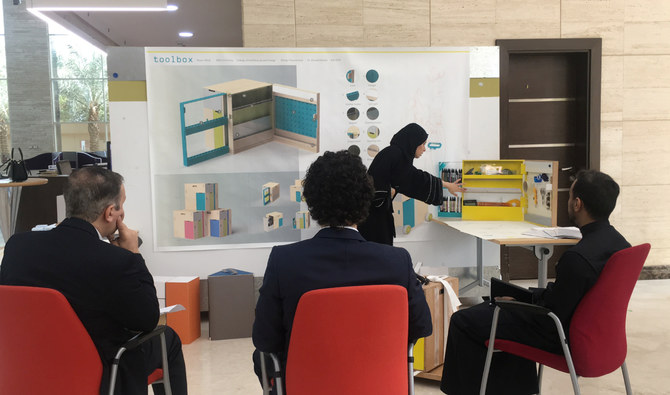While the industrial design remains a male-dominated profession in most parts of the world, women are at the forefront of the discipline in Saudi Arabia, with undergraduate courses on the subject currently being reserved exclusively for female students.
Kyiv. Ukraine. Ukraine Gate – September 06, 2021 – Entrepreneurs
However, this academic dominance has yet to translate into a strong female presence in the workplace, as Saudi female industrial design graduates are still struggling to find suitable employment opportunities. This is largely due to a lack of awareness of the importance of the profession, given that industrial design is a relatively new area of ??specialization in the Kingdom.
“Industrial designers design everything people interact with, including tangible and intangible products and services on the ground and in the virtual world,” Ahmed Kassab, an expert industrial designer, consultant, and university lecturer, told Arab News.
“For example, we design customer experience processes for service providers – such as when people visit a bank for a particular service, where will they sit or wait, and in what way and with what tools will they receive the requested service?”
Kassab believes that industrial design is at its core a strategic problem-solving process that helps drive innovation, provides the building blocks for business success, and improves the quality of life through the development of innovative products, systems, services, and experiences. As a result, it has a central role in achieving the goals of the development plan of the Kingdom’s Vision 2030.
“Saudi Arabia’s Vision 2030 is based on economic growth, creativity, and innovation – and the only field of study that depends on these three elements is industrial design,” Kassab said. Although product design is generally viewed as a relatively young discipline, its origins can be traced back to the mid-18th century and the Industrial Revolution. Kassab describes it as a pillar of modern civilization.
“The first world countries have become the first world countries because of their manufacturing power,” he said. It is the field of specialization that has helped the growth of economies and militaries. The countries that realized the importance of this field of study in the (the 1920s) are the strong ones now.”
However, he said that there are a number of factors preventing Saudi Arabia from tapping into the potential of a growing number of talented female industrial designers, the main obstacle being the lack of awareness and communication.
“Factory owners don’t understand that what they really need is people with a background in industrial design to improve their products and invent new products that will greatly help increase demand and revenue,” Kassab said.
“They don’t even know that there are universities in the country that teach this major. On the other hand, universities do not know enough about the many factories in the kingdom.”
He highlighted a number of other challenges, including employers’ reluctance to hire local talent, in an effort to cut costs and common confusion about the difference between industrial designers and industrial engineers.
“Industrial designers design products from the ground up, from idea to effective product,” Kassab said. “Industry engineers are solely responsible for facilitating the production and maintenance of manufacturing machinery.
But what happens in the vast majority of factories is that engineers play the role of designers. Through my visits to factories in Saudi Arabia, on many occasions, I have discovered small flaws across the manufacturing chain that if fixed would earn billions in the blink of an eye – but no one would help them figure out except for the industrial designer. ”
He added that the only way to solve the current challenges facing the sector is for the government to take measures to ensure that industrial designers are effectively employed in their right roles.
Saudi Arabia’s Vision 2030 is based on economic growth, creativity, and innovation – and the only field of study that relies on these three elements is industrial design.
Ahmed Kassab, industrial designer, consultant, and lecturer at Effat University
Last year, the Saudi Ministry of Culture established the Architecture and Design Authority, headed by Somaya Al-Sulaiman. According to Kassab, this reflects the official awareness of the importance of industrial design. However, the Ministry of Industry and Mineral Resources did not take any action to sponsor and develop the sector.
Kassab is a teacher at Effat University in Jeddah, one of the leading institutions in the Kingdom to study design. The university, which caters exclusively to female students, was the first in Saudi Arabia to offer an industrial design course, and the first batch of Saudi students graduated in 2018. Three universities in the kingdom now offer industrial design courses, all exclusively for women.
Last month, Effat University hosted the Saudi Industrial Design Week, which featured local and international speakers and prominent figures in the field.
Fotun Kardawi studied industrial design at Effat University and now works with Firnas Aero, a startup specializing in drone technology. She is the only product designer on the team that is based at King Abdullah University of Science and Technology.
“It is not easy to find jobs directly related to product design,” she told Arab News. “Although it is a very important job, it is still new to the (local job) market. However, I see product design as the most promising discipline in the field of design.”
Wherever I go, I want to enjoy this trip. There is no end; My journey experience is growing with me and I intend to enjoy it to the fullest.
As a result of the great diversity of work and the ubiquity of applications, Al-Kardawi believes that Saudi graduates will have plenty of opportunities in the coming years as product design becomes more firmly established as an important and valuable profession in the Kingdom.
Kassab agreed, saying: “There is an unimaginable number of jobs in Saudi Arabia in this field, and they are absolutely countless. The only challenge is the lack of awareness, which causes a lack of communication.”
He said that industrial designers in Saudi Arabia are very talented, and he is confident that the challenges will be overcome, that teaching this subject has become more relevant to the needs of the industry and will open up more opportunities for industrial design for men and women.
“Once the field is established, Saudi Arabia will be a different country, within five years,” he said.
Raghad Halabi, also a graduate of Product Design from Effat University, works for another innovative KAUST-based startup, Uvera, which is developing a chemical-free process that uses UV rays to extend the shelf life of fresh foods and reduce waste.
Describing her chosen profession, she remembered the words of the professor who told her, “Once you become a product designer, you will be like a joker card – you will find work wherever you go.”
As in any job, there are challenges, and Halabi highlighted one issue you face often.
“I usually fail to find the right materials I need for our products,” she said. This is due to the shortage of material providers in the Kingdom, as well as the lack of data records for service providers, which is a communication issue.
Kassab said he is proud of the way the design department at Effat University has evolved and improved in the relatively short time since its establishment, to the point that its results are close to matching leading international schools such as Parsons School of Design in New York and Coventry University in the UK.
“Despite the problems the department faced in its first year, it managed to improve steadily,” he said. “We realized our mistakes and improved the performance. Now our department is the only one in the country where the professors are not academics but have experience in the industry. ”
Halabi said she thinks of the design as a journey.
“Wherever I go, I want to enjoy this journey,” she said. “There is no end; My journey experience is growing with me and I intend to enjoy it to the fullest.”
Read also: Inserting Ten Ukrainian Universities in the World University Rankings
Source: Ukrgate







